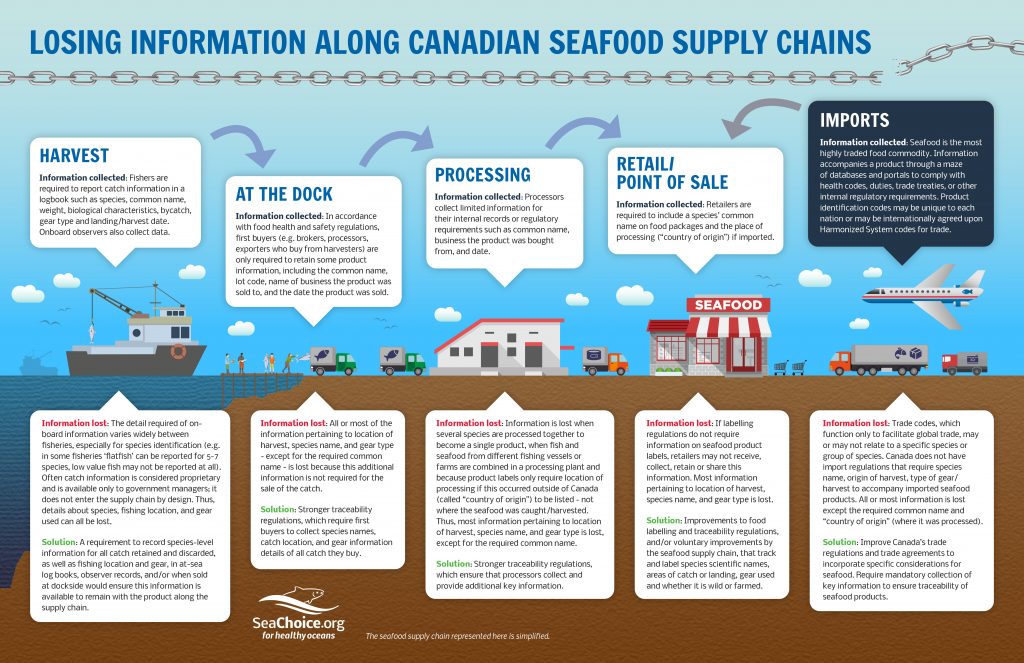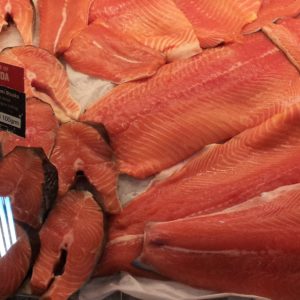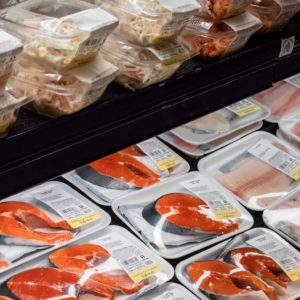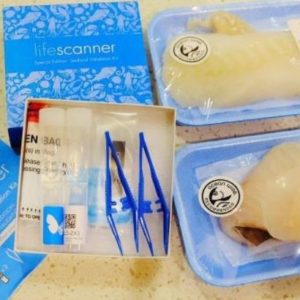Traceability
Seafood traceability is critical to strengthening sustainable fisheries management, deterring illegal practices, verifying environmental and social responsibility claims, and allowing Canadians to support local, sustainable seafood producers.
Consumers increasingly want to know if their seafood choices are environmentally responsible, as well as legally and ethically produced. Today, most businesses cannot answer these basic questions because they do not trace products from water to plate except for basic food safety information. And those who have more sustainable and socially responsible practises can’t get the benefits they deserve.
To solve this problem, companies use different processes and technologies to collect information about the products they buy and sell. There are varying levels at which industry can implement a tool called “traceability”. Traceability is the ability to access information about a product throughout its supply chain by way of recorded identification.
Some seafood products are relatively easy to trace, but others can be much more complicated. Consider a vessel in the British Columbia trawl fleet that has two types of fishing gear (mid-water and bottom trawls) and regularly catches 20 species of fish. Maintaining traceability through the landing, processing and distribution steps is exceptionally challenging. However, traceability for all seafood sold is key to ensuring information about the product moves from harvest to plate.

While there are different types of traceability systems, to be effective, they must:
- Start collecting and maintain data at the point of harvest
- Use a label or other identifier physically attached to the product that traces what it is, where it came from, and how it was produced, as well as its movement throughout the supply chain
- Maintain records and processes that make data shareable and accessible, within and across businesses and governments as appropriate
- Include independent verification
With effective traceability, businesses can verify the environmental sustainability and social responsibility of products they purchase. Companies and investors can be protected from regulatory and reputational risks. Producers and suppliers who maintain sustainable practices can get the recognition they have earned, and governments can better manage their resources.
Canada’s “boat-to-plate” traceability program
In recognition of the importance of traceability for producers, distributors, retailers and consumers, the Federal government committed in 2019 to implementing a boat-to-plate traceability program for seafood sold in Canada. SeaChoice is working to make sure they deliver on that promise:
- in February 2023, SeaChoice collaborated with Oceana Canada to produce recommendations for an interdepartmental task force on boat-to-plate seafood traceability.
- In March 2022, SeaChoice appeared as a witness to the House of Commons Standing Committee on Fisheries and Oceans to provide insights into their seafood traceability and labelling study (see our briefing to the committee here).
- In December 2021, SeaChoice signed on to a letter with 25 seafood companies, grocery stores and experts calling for improved traceability requirements for all seafood sold in Canada. We also submitted our recommendations and comments during the government’s public consultation on this program (see our full submission here).
- In November 2021, we conducted a survey of over 1,000 Canadians on their attitudes to seafood traceability and labelling and found that the majority of Canadians support improvement to traceability of seafood in Canada and would like to see more information about seafood products on their labels.
- Our petition in September 2020 garnered over 5,600 signatures from engaged consumers who want to see proper seafood traceability implemented.
Sign up for our newsletter at the bottom of this page to be kept informed on how you can support the government’s promise going forward.
Our Work on Improving Traceability of Seafood in the Supply Chain
SeaChoice and its partner organizations are working on various projects to improve seafood traceability.
For years, SeaChoice and other organizations have advocated for stronger traceability within the seafood supply chain. From 2017-2019 we engaged in federal food policy consultations, submitting recommendations for how Canada’s regulatory requirements could be more robust. For more information on how SeaChoice thinks Canada should implement stronger traceability requirements see our contributions to the Safe Food for Canadians Regulations and Food Labelling Modernization Initiative. We also garnered support from 3,200 Canadians who agreed to #JoinTheShift in the fall of 2018 by signing a letter asking their retailers to source local, traceable, properly labelled fish.
At an operational level, we are working with the BC trawl sector and KnowYour.Fish, a traceability platform developed by Vericatch. Although the platform has been functional since 2019, it has not been widely adopted. We continue to work with the supply chain and retailers to procure fish from this fishery and ultimately label products with the detailed information that is maintained with each fish.
SeaChoice is actively involved in initiatives for improved seafood traceability globally, such as the Global Dialogue for Seafood Traceability (GDST), a business-to-business platform advancing interoperable seafood traceability internationally.
SeaChoice is working with retailers toward voluntary improvements of labelling and traceability best practices.
One way we are monitoring voluntary improvements is through our Canada-wide index on seafood labelling accuracy and quality by major retailers. We are also motivating voluntary improvements through Seafood Progress – SeaChoice’s online resource for consumers to find out what Canada’s largest retailers are doing to support sustainable seafood.





